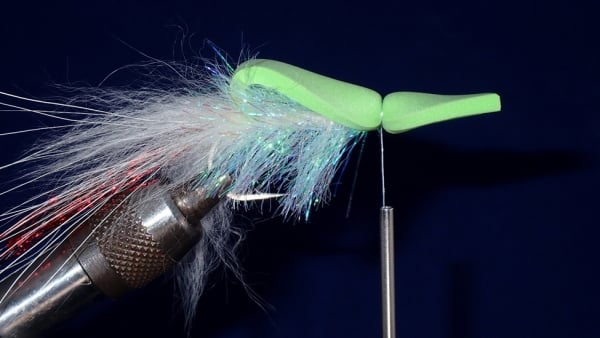About the Gurgler Fly
Fundamentally, there couldn’t be a more straightforward, simpler fly to tie than a Gurgler Fly. Conceived in the 1980s by fly tyer Jack Gartside for New England stripers, the Gurgler has been adapted to just about any species in fresh, salt or tropical waters that will respond to a top-water fly. Australians have an idiom—Down the Gurgler—that characterizes efforts that have been a waste of time and/or money or items lost, never to be found again. In the case of the Gartside Gurgler fly, efforts in tying and fishing this simple fly will never go “Down the Gurgler”.
The original gurgler fly was tailed with white bucktail with a bit of flash, a under body of palmered grizzly hackle and a 3mm white foam body. The classic folded foam body with a short lip in front of the hook eye hasn’t changed in the 40 years this pattern has been around. What has changed however is the adaptation of the myriad of synthetic flash materials available today to this versatile pattern.
Most of my experience with the Gurgler pattern has been on saltwater flats in Florida for Speckled Trout, Snook and Redfish but it is easy to see how the pattern has been adapted to bass, trout, panfish, and northern pike to name just a few.

Any Gurgler Fly is fundamentally a three part fly—tail, foam and body—and as far I as can tell, always tied in that order. It is a simple recipe.
Tying the Gurgler Fly
Hook: Any freshwater or saltwater streamer style hook sized appropriately to the desired pattern.
Thread: Thread can be any color, weight appropriate for the size and purpose of the fly.
Tail: Any combination of fur, feathers, flash in an appropriate length and color for the desired pattern. (Shrimp eyes can be added to simulate a floating shrimp, i.e. the Shrimp Gurgler Fly)
Underbody: Palmered hackle over dubbing, polar chenille, Estaz, cactus chenille, rubber legs etc.
Foam: 2-4mm closed cell foam in any appropriate color for the desired pattern

Whatever tailing material is used, it becomes the first step in the Gurgler Fly tying sequence and is typically tied in at the top of the hook bend and secured up to two-thirds forward on the hook shank.


After the tail is secured, the foam is attached to the hook shank and secured on top of the tailing material. The foam tag can be short or long but the final wraps should be at the top of the hook bend. The actual shape of the foam can be varied but the most typical form is a narrow piece of rectangular foam slightly narrower than the hook gap. Usually the length of the rectangle should be twice the length of the hook shank. One end of the rectangle is then trimmed to create a narrow attachment point for the foam. There are cutters available from River Road Creations for the Gurgler Fly foam body that have a long narrow attachment segment and indentations for the front of the Gurgler Fly foam tie down but they are sized for specific hook sizes.
Once the foam is attached, body material can be tied in and wound forward for about two thirds of the hook shank and tied off. Wrap a thread base to the hook eye and back to the body material tie off.

The final step in Gurgler Fly construction is folding over the foam to tie down behind the hook eye. Generally, depending of the overall size of the fly, the tie-down point should be at least 1/8” behind the hook eye.

The foam is usually loosely humped up over the back of the fly to create a tear drop profile from the side. This actually adds to the buoyancy of the fly and gives the body materials some room to move around in the water. Once the foam is tied down, it is usually trimmed to leave about 1/8 – ¼” of foam beyond the hook eye. This lip causes the fly to “Gurgle” when the fly is moved across the top of the water. Some gurglers are tied with this lip folded back to create a larger, more blunt head.


Gurgler variations are essentially infinite as various tailing materials, body materials and foam colors can be combined on just about any size hook to create a unique fly. A good example of this adaptation of various materials is the Shrimp Gurgler. Instead of a more traditional baitfish tail, shrimp eyes, a short carapace of fur and some long crystal flash antenna form the tail of the fly. Body material and foam colors are suitable for typical shrimp patterns. Bass anglers can add rubber legs, rubber tails and weed guards to the gurgler to create a more traditional bass popper style gurgler that can be fished in weed beds and tight cover. Gurglers tied on small dry fly hooks can be used for bluegill and other panfish. One effective variation is the addition of a glass rattle under the rear of the body. This creates a very noisy Gurgler that can be enticing to fish focusing on topwater targets.

Fishing a Gurgler is not much different than fishing any sort of topwater lure or fly for your target species. Typically the fly is cast out and slow twitched back with short strips while allowing it to sit idle for a bit between strips. All that said, the target species and conditions will dictate how your gurglers are fished. One of my favorite methods of fishing the Gurgler for Speckled Trout along the Florida Gulf coast grass flats is a “Hopper-Dropper” clone. I tie a 2-3’ dropper from the Gurgler with a lightly weighted shrimp pattern. This mimics the Popping Cork setups bait anglers use for Speckled Trout. The Gurgler attracts the attention of the trout which then targets the easy prey of the suspended shrimp pattern.

The Gartside Gurgler pattern has not only proven itself effective for decades, the simplicity of the pattern makes it an easy choice for fly tiers. Regardless of your target species, if you like to fish topwater patterns tie up some simple flies – the Gurgler.


2 comments
bob a jean
I like it going to give it a try
bob a jean
I like it going to give it a try